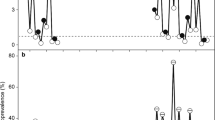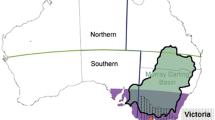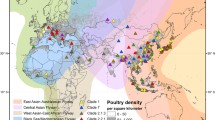Abstract
In January 2006, a major cold spell affected Europe, coinciding with an increase of H5N1 influenza virus detected in wild birds, mostly dead mute swans, starting along the River Danube and the Mediterranean coast line. Subsequently H5N1 detections in wild birds were concentrated in central and western parts of Europe, reaching a peak in mid February. We tested the hypothesis that the geographic distribution of these H5N1 infections was modulated by the long-term wintering line, the 0°C isotherm marking the limit beyond which areas are largely unsuitable for wintering waterfowl. Given the particularly cold 2005–2006 European winter, we also considered the satellite-derived contemporary frost conditions. This brought us to select the long-term maximum rather than the mean January 0°C isotherm as the best approximation for the 2005–2006 wintering line. Our analysis shows that H5N1 detection sites were closer to the wintering line than would be expected by chance, even when the geographic distribution of water bird wintering sites was accounted for. We argue that partial frost conditions in water bodies are conducive to bird congregation, and this may have enhanced H5N1 transmission and local spread. Because the environmental virus load also would build up in these hot spots, H5N1 virus may have readily persisted during the spring, at least in cooler areas. We conclude that H5N1 introduction, spread, and persistence in Europe may have been enhanced by the cold 2005–2006 winter.



Similar content being viewed by others
References
Alerstam T (1990) Bird migration. Cambridge University Press, UK
Arzel C, Elmberg J, Guillemain M (2006) Ecology of spring migrating Anatidae: a review. Journal of Ornithology 147:67-184
Atkinson PW, Clark JA, Delany S, Diagana CH, du Feu C, Fiedler W, et al. (2006) Urgent preliminary assessment of ornithological data relevant to the spread of Avian Influenza in Europe. In: Report to the European Commission, Delany S, Veen J, Clark JA (editors), Study contract: 07010401/2005/425926/MAR/B4
Augustin NH, Mugglestone MA, Buckland ST (1996) An autologistic model for the spatial distribution of wildlife. Journal of Applied Ecology 33:339-347
Avram M (2008) The role of domestic waterfowl in H5N1 virus transmission in the Danube delta. Consultancy report. Food and Agriculture Organization of the United Nations. EMPRES. Rome, Italy
Baillie SR, Clark NA, Ogilvie MA (1986) Cold weather movements of waterfowl and waders: an analysis of ringing recoveries. BTO Research Report 19, Tring: British Trust for Ornithology
Baldassare GAR, Whyte RJ, Bolen EG (1986) Body weight and carcass composition of nonbreeding Green-winged Teal on Southern High Plains of Texas. Journal of Wildlife Management 50:420–426
BirdLife International (2006) BirdLife statement on avian influenza. BirdLife International. Available: http://www.birdlife.org/action/science/species/avian_flu/
Boos M, Zorn T, Le Maho Y, Groscolas R, Robin JP (2002) Sex differences in body composition of wintering mallards (Anas platyrhynchos): possible implications for survival and reproductive performance. Bird Study 49:212–218
Breban R, Drake JM, Stallknecht DE, Rohani P (2009) The role of environmental transmission in recurrent avian influenza epidemics. Plos 5:e1000346
Bregnballe T, Frederiksen M, Gregersen J (2006) Effects of distance to wintering area on arrival date and breeding performance in Great Cormorants Phalacrocorax carbo. Ardea 94:619-630
Brown JD, Goekjian G, Poulson R, Valieka S, Stallknecht DE (2009) Avian influenza virus in water: infectivity is dependent on pH, salinity and temperature. Veterinary Microbiology 136:20-26
Cao C, Barter M, Lei G (2008) New Anatidae population estimates for eastern China: implications for current flyway estimates. Biological Conservation 141:2301-2309
Chen H, Li KS, Wang J, Fan XH, Rayner JM, et al. (2006) Establishment of multiple sublineages of H5N1 influenza virus in Asia: implications for pandemic control. Proceeding National Academy of Science USA 103:2845–2850
Choundhury S, Black JM (1991) Testing the behavioral dominance and dispersal hypothesis in Pochard. Ornis 22:155-159
Cramp S, Simmons K (1977) Birds of the Western Paleartic: Handbook of the Birds of Europe, the Middle East and North Africa. Vol I (Ostriches to Ducks). Oxford: Oxford University Press
Crick HQP, Atkinson PW, Newson SE, Robinson RA, Snow L, Balmer DE, et al. (2006) Avian Influenza Incursion Analysis (through wild birds). BTO Research Report 448, Thetford: British Trust for Ornithology
Danish Veterinary and Food Administration (2007) Highly pathogenic avian influenza H5N1 in Denmark, Spring 2006- Report. Available: www.fvst.dk. Accessed 22 March 2008
Delany S, Scott D (2006) Waterbird Population estimates-Fourth Edition, Wageningen: Wetlands International
Dormann CF, Mc Pherson MJ, Araujo MB, Bivand R, Bolliger J, Carl G, et al. (2007) Methods to account for spatial autocorrelation in the analysis of species distributional data: a review. Ecography 30:609-628
Drent RH, Fox AD, Stahl J (2006). Travel to breed. Journal of Ornithology 147:122–134
Feare CJ, Yasué M (2006) Asymptomatic infection with highly pathogenic avian influenza H5N1 in wild birds: how sound is the evidence? Virology Journal 3:96
Food and Agriculture Organization of the United Nations (2006) Emergency Prevention System Global animal disease information system. Available: http://www.fao.org/ag/againfo/programmes/en/empres/home.asp
Gaidet N, Dodman T, Caron A, Balanca G, Desvaux S, Goutard F, et al. (2007) Influenza surveillance in wild birds in Eastern Europe, the middle East and Africa: preliminary results from an ongoing FAO-led survey. Journal of Wildlife Disease 43:S22-S28
Gaidet N, Cattoli G, Hammoumi S, Newman S, Hagemeijer W, Takekawa JY, et al. (2008) Evidence of infection by H5N2 highly pathogenic avian influenza viruses in healthy wild waterfowl. Plos Pathogen 4:e1000127
Gauthier-Clerc M, Lebarbenchon C, Thomas F (2007) Recent expansion of highly pathogenic avian influenza H5N1: a critical review. Ibis 149:202-214
Gill JS, Webby R, Gilchrist MJR, Gray GC (2006) Avian influenza among waterfowl hunters and wildlife professionals. Emergency Infectious Disease 12:1284-1286
Gilbert M, Xia XM, Domenech J, Lubroth J, Martin V, Slingenbergh J (2006) Anatidae migration in the Western Paleartic and the spread of highly pathogenic avian influenza H5N1 virus. Emergency Infectious Disease 12:1650-1656
Gilissen N, Haanstra L, Delany S, Boere G, Hagemeijer W (2002) Numbers and distribution of wintering waterbirds in the Western Palearctic and Southwest Asia in 1997, 1998 and 1999. Results from the International Waterbird Census. Wetlands International Global Series No. 11, Wageningen: Wetlands International
Globig A, Staubach C, Beer M, Koppen U, Fiedler W, Nieburg M, et al. (2009) Epidemiological and ornithological aspects of outbreaks of highly pathogenic avian influenza virus H5N1 of Asian lineage in wild birds in Germany, 2006 and 2007. Transboundary Emergency Disease 56:57-72
Hars J, Ruette S, Benmergui M, Fouque C, Fourneir J, Legouge A, et al. (2008) The epidemiology of the highly pathogenic H5N1 avian influenza in mute swan (Cygnus olor) and other Anatidae in the Dombes region (France), 2006. Journal Wildlife Disease 44:811-823
Hijmans RJ, Cameron SE, Parra JL, Jones PG, Jarvis A (2005) Very high resolution interpolated climate surface for Global Land areas. International Journal of Climatology 25:1965-1978
Hofmann MA, Renzullo S, Baumer A (2008) Phylogenetic characterization of H5N1 highly pathogenic avian influenza viruses isolated in Switzerland in 2006. Virus Genes 37:407-413
Kalthoff D, Breithaupt A, Teifke JP, Globig A, Harder T, Mettenleiter TC, Beer M (2008) Highly pathogenic avian influenza virus (H5N1) in experimentally infected adult mute swans. Emerging Infectious Diseases 14:1267-1270
Keawcharoen J, van Riel D, Amerongen G, Bestebroer T, Beyer WE, van Lavieren R, et al. (2008) wild ducks as long-distance vectors of highly pathogenic influenza (H5N1). Emerging Infectious Disease 12:1650-1656
Keitt TH, Bjørnstad ON, Dixon PM, Citron-Pousty S (2002) Accounting for spatial pattern when modeling organism-environment interactions. Ecography 25:616–625
Keller I, Korner-Nievergelt F, Jenni L (2009) Within-winter movements: a common phenomenon in the common pochard Aythya farina. Journal of Ornithology 150:483-494
Kilpatrick AM, Chmura AA, Gibbons DW, Fleischer RC, Marra PP, Daszak P (2006) Predicting the global spread of H5N1 avian influenza. Pnas 103:19368-19373
Kreuzbergh-Mukhina EA (2006) The effect of habitat change on the distribution of waterbirds in Uzbekistan and the possible implications of climate change. In: Waterbirds Around the World, Boere GC, Galbraith CA, Stroud DA (editors), Edinburgh, UK: The Stationery Office, pp 277-282
Lang AS, Kelly A Runstadler JA (2008) Prevalence and diversity of avian influenza viruses in environmental reservoirs. Journal of General Virology 89:509-519
Longcore JR, Gibbs JP (1988) Distribution and numbers of American Black ducks among the Maine coast during the severe winter of 1980–1981. In: Waterfowl in Winter, Weller MW (editor), Minneapolis: University of Minnesota Press, pp 377–389
McPherson JM, Jetz W, Rogers DJ (2004) The effects of species’ range sizes on the accuracy of distribution models: ecological phenomenon or statistical artefact? Journal of Applied Ecology 41:811-823
Munoz MJ, Sanchez-Vizcaìno JM, Peris S (2006) Short communication. Can highly pathogenic influenza (HPAI) reach the Iberia peninsula from Asia by means of migratory birds? Spanish Journal of Agricultural Research 4:140-145
Nagy A, Machova J, Hornickova J, Tomci M, Nagl I, Horyna B, Holko I (2007) Highly pathogenic avian influenza virus subtype H5N1in mute swans in the Czech Republic. Veterinary Microbiology 120:9–16
Nankinov DN (1996) Coastal parks and reserves along the Black Sea and their importance for seabirds. Marine Ornithology 24:29-34
Newman SH, Honhold N, Erciyas K, Sanz-Alvarez J (2008) Investigation of the role of wild birds in highly pathogenic avian influenza outbreaks in Turkey between January and February 2008: Turkey Mission Report. Food and Agriculture Organization of the United Nations EMPRES, Rome, Italy
Nilsson L (1979) Variation in the production of young of swans wintering in Sweden. Wildfowl 30:129–134
NOAA/NESDIS/OSDPD/SSD (2006) IMS Daily Northern Hemisphere Snow and Ice Analysis at 4 km and 24 km Resolution. Boulder, CO: National Snow and Ice Data Center. Digital media
Owen M, Cook WA (1977) Variations in body weight, wing length and condition of Mallard Anas platyrhynchos and their relationship to environmental changes. Journal of Zoology 183:377–395
Pinto JG, Brücher T, Fink AH, Krüger A (2007) Extraordinary snow accumulations over parts of central Europe during the winter of 2005/06 and weather-related hazards. Royal Meteorological Society, Weather 62:16-21. doi: 10.1002/wea.19
Prosser D, Takekawa JY, Newman SH, Yan B, Douglas DC, Hou Y, et al. (2009) Satellite-marked waterfowl reveal migratory connection between H5N1 outbreak areas in China and Mongolia. Ibis 151:568-576
Ridgill SC, Fox AD (1990) Cold weather movements of waterfowl in Western Europe. Slim bridge: IWRB Special Publication 13
Rinder M, Lang V, Fuchs C, Hafner-Marx A, Bogner K, Neubauer A, et al. (2007) Genetic evidence for multi-event imports of avian influenza virus A (H5N1) into Bavaria, Germany. Journal Veterinary Diagnostic Investigation 19:279-282
Root T (1988) Environmental factors associated with avian distributional boundaries. Journal of Biogeography 15:489-505
Rustamov AN, Kovshar AF (2007) The Birds of Middle Asia, Almaty
Saad MD, Ahmed LS, Gamal-Eldein MA, Fouda MK, Khalil FM, et al. (2007) Possible avian influenza (H5N1) from migratory bird, Egypt. Emerging Infectious Disease 13:1120–1121
Sabirovic M, Wilesmith J, Hall S, Coulson N, Landeg F (2006) Situation analysis – outbreaks of HPAI H5N1 virus in Europe during 2005/2006: an overview and commentary. London: Department of Environment, Food and Rural Affairs. Available: http://www.defra.gov.uk/animalh/diseases/monitoring/index.htm
Scaife AA, Knight JR (2008) Ensemble simulations of the cold European winter of 2005–2006. Quarterly Journal of the Royal Meteorological Society. doi:10.1002/qj.312
Scott DA, Rose PM (1996) Atlas of Anatidae populations in Africa and western Eurasia Wageningen: Wetlands International. Available: http://www.wetlands.org
Si Y, Skidmoire AK, Wang T, de Boer WF, Debba P, Toxopeus AG, et al. (2009) Spatio-temporal dynamics of global H5N1 outbreaks match bird migration patterns. Geospatial Health 4:65-78
Spencer R (1982) Birds in winter: an outline. Bird Study 29:169-182
Starick E, Beer M, Hoffmann B, Staubach C, Werner O, Globig A, et al. (2008) Phylogenetic analyses of highly pathogenic avian influenza virus isolates from Germany in 2006 and 2007 suggest at least three separate introductions of H5N1 virus. Veterinary Microbiology 128:243-252
Steffen O, Powell AN, Dickson DL (2008) Timing and distance of king eider migration and winter movements. The Condor 110:296–305. DOI 10.1525/cond.2008.8502
Stumberger B (1999) Results of the mid-winter waterfowl counts in January 1999 in Slovenia. Acrocephalus 20:6-22
Stumberger B (2000) Results of the mid-winter waterfowl counts in January 2001 in Slovenia. Acrocephalus 21:261-274
Stumberger B (2001) Results of the mid-winter waterfowl counts in January 2001 in Slovenia. Acrocephalus 22:171-174
Stumberger B (2002) Results of the mid-winter waterfowl counts in January 2002 in Slovenia. Acrocephalus 23:43-47
Stumberger B (2005) Results of the mid-winter waterfowl counts in January 2001 in Slovenia. Acrocephalus 26:99-103
Suter W, Van Eerden MR (1992). Simultaneous mass starvation of wintering diving ducks in Switzerland and the Netherlands: a wrong decision in the right strategy? Ardea 80:229-242
Szeleczky Z, Dán A, Ursu K, Ivanics E, Kiss I, Erdélyi K (2009) Four different sublineages of highly pathogenic avian influenza H5N1 introduced in Hungary in 2006–2007. Veterinary Microbiology 139:24-33
Tucakov M (2005) Numbers and seasonal activity of the mute swan (Cygnus olor) on the Kolut fishpond (NW Serbia). Ring 27:221-226
Van Gils JA, Munster VJ, Radersma R, Liefhebber D, Fouchier RAM, Klaassen M (2007) Hampered foraging and migratory performance in swans infected with low-pathogenic avian influenza A virus. Plos one 2:e184
Ward P, Maftei D, Apostu C, Suru A (2008) Geostatistical visualisation and spatial statistics foe evaluation of the dispersion of epidemic highly pathogenic avian influenza subtype H5N1. Veterinary Research 39:22
Weber TP, Stilianakis NI (2007) Ecological immunology of avian influenza (H5N1) in migratory birds. Emerging Infectious Disease 13:1139-1143
Weber TP, Stilianakis NI (2008) Migratory birds, the H5N1 influenza virus and the scientific method. Virology Journal 5:1-3
White RJ, Bolen EG (1984) Impact of winter stress on mallard body composition. Condor 86:477-482
Wilking H, Ziller M, Staubach C, Globig A, Harder TC, Conraths FJ (2009) Chances and limitations of wild bird monitoring for the avian influenza virus H5N1. Detection of pathogens highly mobile in time and space. Plos 4:e6639
Disclaimer
The views expressed in the publication are those of the authors and do not necessarily reflect the views of the Food and Agriculture Organization of the United Nations.
Author information
Authors and Affiliations
Corresponding author
Electronic supplementary material
Rights and permissions
About this article
Cite this article
Ottaviani, D., de la Rocque, S., Khomenko, S. et al. The Cold European Winter of 2005–2006 Assisted the Spread and Persistence of H5N1 Influenza Virus in Wild Birds. EcoHealth 7, 226–236 (2010). https://doi.org/10.1007/s10393-010-0316-z
Received:
Revised:
Accepted:
Published:
Issue Date:
DOI: https://doi.org/10.1007/s10393-010-0316-z




